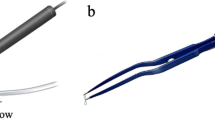Abstract
Several techniques and devices have recently been developed in an effort to allow safer liver resections and avoid intraoperative blood loss. The aim of this study was to analyze our initial experience with hepatic resections using a new water-cooled, high-density, monopolar device—the Tissuelink Monopolar Floating Ball (Tissuelink Medical, Inc., Dover, NH)—in order to avoid bleeding during hepatic surgery. We analyzed patients who underwent hepatic surgery between January and June 2003. Sex, age, type of disease, and type of surgical procedure, in association with the duration of the surgical procedure, blood loss, use of vascular clamping of the liver, length of hospital stay, morbidity, and mortality were analyzed. Seven minor liver resections, two major liver resections, and one total cystopericystectomy were performed with the use of this new device. Average blood loss was 150 ml (range 50 to 300 ml). No vascular clamping was used with the exception of one patient. No deaths were recorded. Morbidity included ascites in one case and pleural effusion in another. In conclusion, the Tissuelink Monopolar Floating Ball permitted excellent coagulation of the cut liver surface, thus avoiding bleeding and vascular clamping. As a result, postoperative morbidity and mortality were low.
Similar content being viewed by others
References
Takayama T, Makuuchi M. Prevention of hepatocellular carcinoma recurrence: Actuality and perspectives. Hepatogastroenterology 2002;49:87–90.
Adam R, Huguet E, Azoulay D, Castaing D, Kunstlinger F, Levi F, Bismuth H. Hepatic resection after down-staging of unresectable hepatic colorectal metastases. Surg Oncol Clin N Am 2003;12:211–220.
Torzilli G, Makuuchi M, Inoue K. The vascular control in liver resection: Revisitation of a controversial issue. Hepatogastroenterology 2002;49:28–31.
Couinaud C. Surgical anatomy of the liver. Several new aspects. Chirurgie 1886;112:337–342.
Miyagawa S, Makuuchi M, Kawasaki S, Kakazu T. Criteria for safe hepatic resection. Am J Surg 1995;169:589–594.
Yanaga K, Matsumata T, Nishizaki T, Shimada M, Sugimachi R. Alternate hemihepatic vascular control technique for hepatic resection. Am J Surg 1993;165:365–366.
Van Wagensveld BA, van Gulik TM, Gelderblom HC, Scheepers JJ, Bosma A, Endert E, Gouma DJ. Prolonged continuous or intermittent vascular infiow occlusion during hemihepatectomy in pigs. Ann Surg 1999;229:376–384.
Belghiti J, Noun R, Malafosse R, Jagot P, Sauvanet A, Pierangeli F, Marty J, Farges O. Continuous versus intermittent portal triad clamping for liver resection. A controlled study. Ann Surg 1999;229:369–375.
Nagino M, Yamada T, Kamiya J, Uesaka K, Arai T, Nimura Y. Left hepatic trisegmentectomy with right hepatic vein resection after right hepatic vein embolization. Surgery 2003;133:512–520.
Serracino-Ingnotti F, Habib NA, Mathie RT. Hepatic ischemia-reperfusion injury. Am J Surg 2001;58:160–166.
Sundaram CP, Rehman J, Venkatesh R, Lee D, Rageb MM, Kibel A, Landman J. Hemostatic laparoscopic partial nephrectomy by a water-cooled, high density, monopolar device without renal vascular control. Urology 2003;61:906–909.
Sayek I, Onat D. Diagnosis and treatment of uncomplicated hydatid cyst of the liver. World J Surg 2001;25:21–27.
Fan ST, Lai ECS, Lo CM, Chu KM, Liu CL, Wong J. Hepatectomy with an ultrasonic dissector for hepatocellular carcinoma. Br J Surg 1996;83:117–120.
Yamamoto Y, Ikai I, Kume M, Sakai Y, Yamauchi A, Shinohara H, Morimoto T, Shimahara Y, Yamamoto M, Yamaoka Y. New simple technique for hepatic parenchymal resection using a Cavitron Ultrasonic Surgical Aspirator and bipolar cautery equipped with a channel for water dripping. World J Surg 1999;23:1032–1037.
Weber JC, Navarra G, Jiao LR, Nicholls JP, Jensen SL, Habib NA. New technique for liver resection using heat coagulative necrosis. Ann Surg 2002;236:560–563.
Rau HG, Buttler ER, Baretton G, Schardey HM, Schildberg FW. Jet-cutting supported by high frequency current: New technique for hepatic surgery. World J Surg 1997;21:254–259.
Author information
Authors and Affiliations
Corresponding author
Rights and permissions
About this article
Cite this article
Di Carlo, I., Barbagallo, F., Toro, A. et al. Hepatic resections using a water-cooled, high-density, monopolar device: A new technology for safer surgery. J Gastrointest Surg 8, 596–600 (2004). https://doi.org/10.1016/j.gassur.2003.12.010
Issue Date:
DOI: https://doi.org/10.1016/j.gassur.2003.12.010




